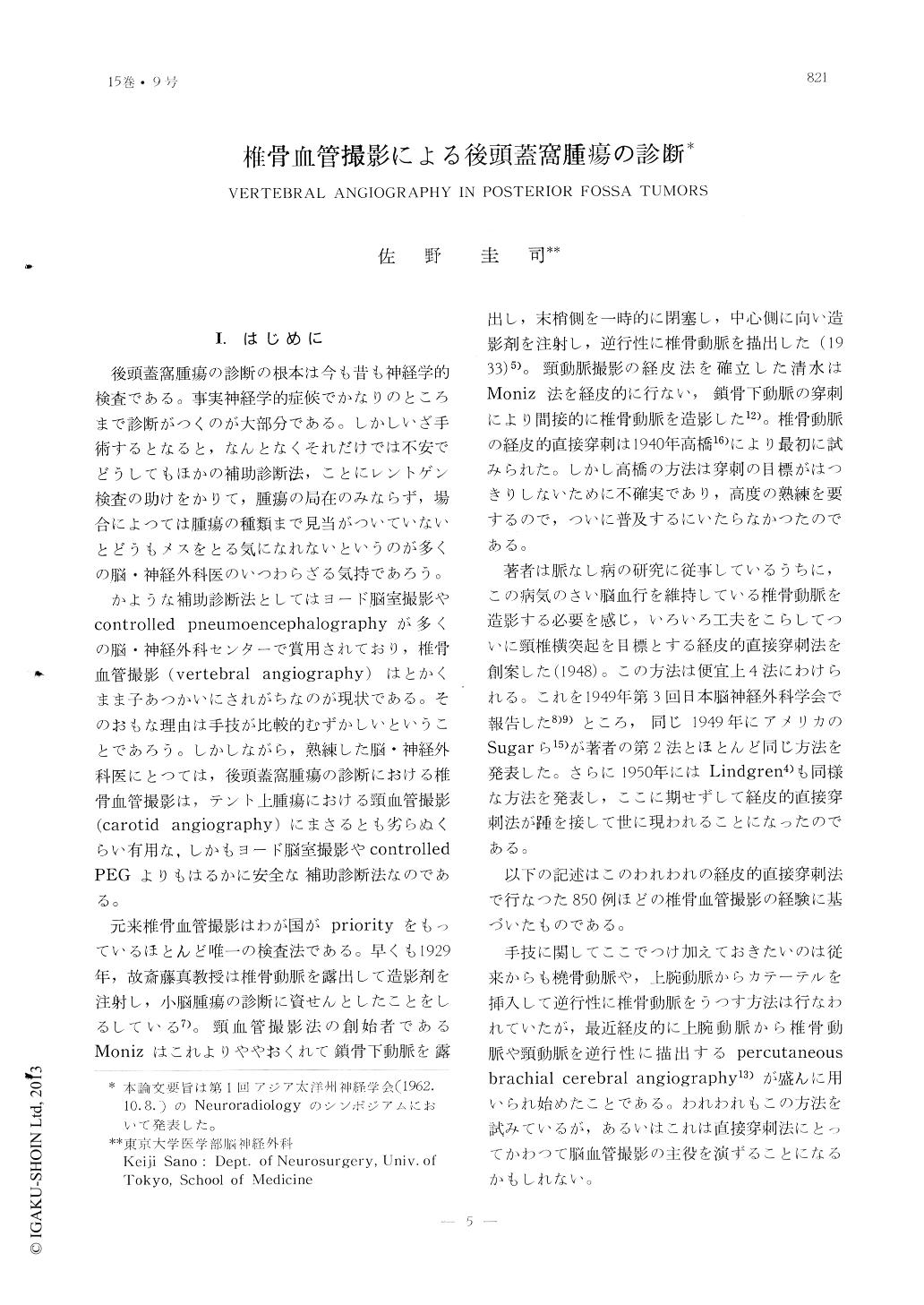Japanese
English
- 有料閲覧
- Abstract 文献概要
- 1ページ目 Look Inside
I.はじめに
後頭蓋窩腫瘍の診断の根本は今も昔も神経学的検査である。事実神経学的症候でかなりのところまで診断がつくのが大部分である。しかしいざ手術するとなると,なんとなくそれだけでは不安でどうしてもほかの補助診断法,ことにレントゲン検査の助けをかりて,腫瘍の局在のみならず,場合によつては腫瘍の種類まで見当がついていないとどうもメスをとる気になれないというのが多くの脳・神経外科医のいつわらざる気持であろう。
かような補助診断法としてはヨード脳室撮影やcontrolled pneumoencephalographyが多くの脳・神経外科センターで賞用されており,椎骨血管撮影(vertebral angiography)はとかくまま子あつかいにされがちなのが現状である。そのおもな理由は手技が比較的むずかしいということであろう。しかしながら,熟練した脳・神経外科医にとつては,後頭蓋窩腫瘍の診断における椎骨血管撮影は,テント上腫瘍における頸血管撮影(carotid angiography)にまさるとも劣らぬくらい有用な,しかもヨード脳室撮影やcontrolled PEGよりもはるかに安全な補助診断法なのである。
The diagnosis of posterior fossa tumors has been and still is founded mainly on neurological signs and symptoms. Among various diagno-stic aids to the neurological examination, the iodo-ventriculography and recently the con-trolled pneumoencephalography are preferred in many neurosurgical centers, and only a mi-nor credit is given to the vertebral angiogra-phy, the main reason of which is probably its technical difficulty. In skilled hands, however, the vertebral angiography is as useful and safe a procedure in diagnostics of posterior fossa tumors as the carotid angiography in supratentorial tumors. One should bear in mind that in the vertebral angiography, positive findings are always valuable, whereas nega-tive findings do not necessarily exculde the existence of tumors. The following statement is based on experinences of vertebral angio-graphy in about 850 cases since the anthor started his own percutaneous technique in 1948.
(Fig. 1) If a tumor in the posterior fossa is sufficiently large, general signs indicating its existence in the lateral vertebral angiogram are as shown in this case of cerebellar astro-cytoma:
(1) elevation of the posterior cerebral and the superior cerebellar arteries,
(2) unrollng and pressing down of the ver-tebral-basilar trunk, and
(3) when the cerebellar herniation is pre-sent, downward displacement of the posterior inferior cerebellar artery and its branches below the foramen magnum.
(Fig.2) If the tumor is lateralized on one side of the posterior fossa, causing shift of the brain-stem, the point of bifurcation of the posterior cerebral arteries is seen to deviate from the midline,and the basilar trunk shows a marked tension and an arched curvature convex towards the normal side in the antero-posterior view, as seen in this case of a huge epidermoid in the left cerebello-pontine angle. The arched curvature of the basilar trunk, however, is by no means a reliable sign, since such a curvature is not infrequently seen in normal cases, although in normal cases the bifurcation point above mentioned is always in the midline.
(Fig. 4) This is a case of acoustic tumor on the left side. One can see the changes of the same kind and the bow-shaped elevation and stretching of the labyrinthine artery on the tumor side.
(Fig. 5) In about one fourth of acoustic tu-mors, the brain-stem shift is very slight or hardly recognized. As seen in the figure, however, the elevation and stretching of the labyrinthine artery circumscribing the tumor is consistently visible. (Fig. 6) This labyrin-thine artery sign can be noticed also in the lateral view, as seen in the figure. The supe-rior cerebellar artery also shows similar chan-ge. Here, in this figure one can notice the downward displacement of the posterior in-ferior cerebellar artery and its branches indi-cating the cerebellar herniation through the foramen magnum. This sign, what the author calls the foraminal sign, is seen in about 70% of posterior fossa tumors. (Fig. 17) In this case of astrocytoma of the cerebellar vermis, the same sign can be noticed. Here the contour of the tumor is fairly well demonstrated by the surrounding cerebellar arteries. (Fig. 3) In this case of ependymoma of the fourth ven-tricle, no abnormality is noted except that there is a marked foraminal sign. Such is often the case with tumors in the fourth ventricle.
(Fig.8) Tumors of the clivus are most ea-sily diagnosed by the vertebral angiography because of the characteristic backward displa-cement of the basilar trunk, as seen in this case of chordoma of the clivus. (Fig.7) Con-trary to this finding, pontine gliomas show an increase in convex curvature and a pro-nounced stretching of the basilar trunk. as seen in the figure.
(Fig. 14) Among various kinds of tumors in the posterior fossa, hemangioblastomas and meningiomas are best demonstrated by verte-bral angiography. This is a solid hemangio-blastoma showing diffuse vascularization.
(Fig. 15,16) And these are cases of cystic he-mangioblastoma in the cerebellar hemisphere. Besides elevation of the posterior cerebral and superior cerebellar arteries, unrolling and pres-sing down of the vertebral-basilar trunk andthe foraminal sign, one can notice a cherry-sized cluster of vessls denoting a mural nodule protruding into a large intracerebellar cyst.
(Fig. 9) This is a case of tentorial meningioma indenting the superior surface of the cerebel-lum. Here one can notice a rich vascularization and circumscribing vessels. (Fig. 12,13) These figures show a meningioma of the angioblastic type in the region of the great cistern protr-uding into the fourth ventricle. There is a well-demarcated, pronounced vascularization with a vein draining into the transverse sinus.
(Fig. 18) Malignant tumors, such as medul-loblastomas, and glioblastomas often show ar-teriovenous fistulae and microaneurysms which are never found in benign tumors. This is a case of medulloblastoma. Besides elevation of the posterior cerebral and superior cerebe-llar arteries and unrolling of the pressed ver-tebral basilar trunk, there is an intra-neopla-stic vascularization. (Fig. 19) This is also a case of medulloblastoma. one can see here an aneurysm-like vascularization as well as art-eriovenous fistulae besides the foraminal sign. Thus the vertebral angiography in posterior fossa tumors is useful not only for their local diagnosis, but sometimes for diagnosis of the nature and the malinancy of the tumors.

Copyright © 1963, Igaku-Shoin Ltd. All rights reserved.


